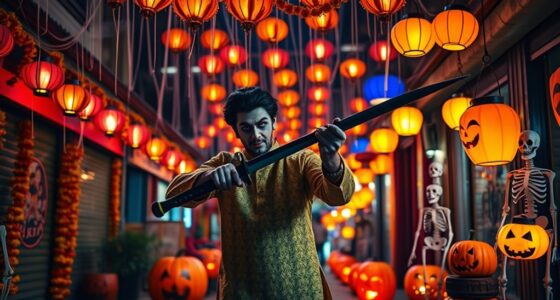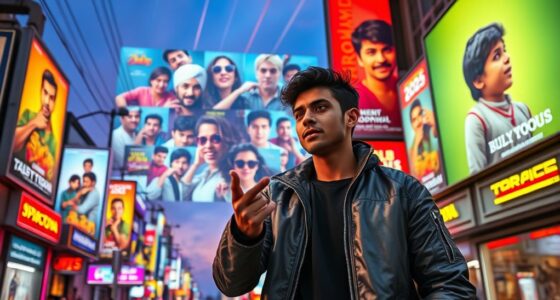Discover how some of Bollywood’s most iconic scenes were almost unscripted, driven by spontaneous reactions and organic improvisation. From the playful “Aao Aao” call in Dilwale Dulhania Le Jayenge to Ranbir and Deepika’s raw breakup in Tamasha, you’ll see how actors’ instincts created unforgettable moments. Scenes like Amitabh Bachchan’s mirror monologue and Shah Rukh Khan’s genuine emotions in Swades showcase trust between actors and directors. Stay with us to explore these powerful, authentic moments that elevated Bollywood storytelling.
Key Takeaways
- Many iconic scenes, like Shah Rukh Khan’s “aao aao” in Dilwale Dulhania Le Jayenge, were improvised on set for authenticity.
- Raw emotional scenes, such as Ranbir and Deepika’s breakup in Tamasha, relied heavily on actors’ instincts rather than scripted dialogue.
- Rain-dance sequences in films like Baazigar used spontaneous reactions and unplanned movements to enhance realism.
- Comedic moments, including Amitabh Bachchan’s mirror monologue in Amar Akbar Anthony, were developed through improvisation.
- Directors’ trust and encouragement fostered natural, unrehearsed performances that became cinematic classics.
The “Aao Aao” Call in Dilwale Dulhania Le Jayenge
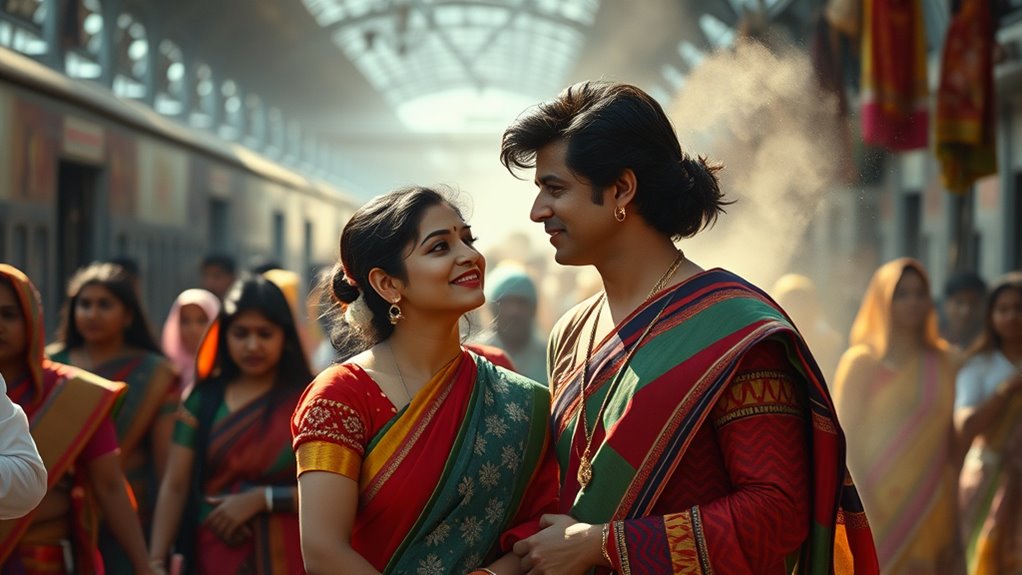
The iconic “Aao Aao” call in Dilwale Dulhania Le Jayenge stands out as a spontaneous moment that adds authenticity and charm to the film. Shah Rukh Khan improvised this scene on set, inspired by how pigeons are summoned in Delhi, and included the phrase “aao, aao.” It wasn’t part of the original script but developed naturally during filming. This impromptu addition brought a genuine, relatable touch to the scene, making it more engaging. The moment became one of the film’s most memorable, highlighting the playful chemistry between Shah Rukh Khan and Kajol. Its authenticity resonated with audiences, showcasing how organic improvisation can elevate a scene. This small but impactful moment exemplifies the film’s blend of spontaneity and realism that endures today, demonstrating how improvisation in DDLJ scenes can enhance the overall storytelling.
Ranbir and Deepika’s Raw Breakup Scene in Tamasha
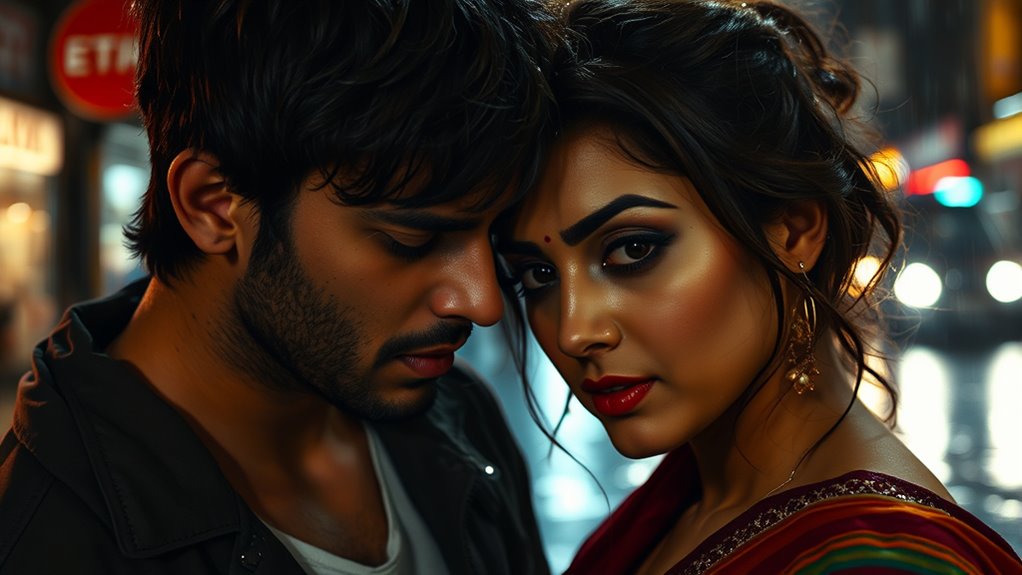
You’ll notice how the breakup scene feels incredibly genuine because Ranbir and Deepika rely on their own emotional instincts rather than scripted lines. Their spontaneous dialogue captures raw moments of pain that resonate deeply with viewers. This natural authenticity makes the scene stand out as one of Bollywood’s most memorable portrayals of heartbreak. Additionally, the actors’ ability to convey such authentic emotion is often enhanced by their familiarity with improvised acting techniques, which allows them to deliver more spontaneous and believable performances. Their deep understanding of emotional expression helps them tap into genuine feelings, making their performances even more compelling. This approach aligns with supporting emotional expression, which is essential for creating impactful, heartfelt scenes. Moreover, their intuitive grasp of acting methods enables them to improvise effectively, adding an extra layer of realism to their performances.
Natural Emotional Authenticity
Ranbir Kapoor and Deepika Padukone deliver a raw, emotionally authentic breakup scene in *Tamasha* by tapping into their own experiences and trusting director Imtiaz Ali’s approach. Ali gave them the freedom to improvise and encouraged genuine emotional expression, allowing their personal feelings to shape the scene. Despite their real-life breakup, they maintained a strong on-screen chemistry, adding depth to their performances. Their ability to connect with the characters’ emotions made the scene feel real and relatable, resonating deeply with viewers. The actors’ performances captured the complexity of heartbreak, creating a moment of profound authenticity. This natural emotional depth, combined with Ali’s directorial trust, elevates the scene beyond scripted dialogue, making it a powerful example of cinematic honesty. The scene is considered a “scenemaaaa” moment, highlighting how spontaneous moments can become iconic in Bollywood. Additionally, this approach demonstrates how emotional authenticity can significantly enhance a performance’s impact, turning a simple scene into an unforgettable cinematic moment. Their willingness to embrace vulnerability and improvise naturally contributed significantly to the scene’s raw power, proving that trusting actors’ instincts can lead to unforgettable results. Furthermore, integrating AI in Education methods such as personalized coaching could have helped actors prepare emotionally for such intense scenes, blending technology with artistry to improve performances. Recognizing the importance of diverse acting techniques can also help actors access deeper emotional layers, making their portrayals even more compelling. Moreover, understanding gaslighting and emotional manipulation can deepen actors’ ability to portray complex psychological states authentically.
Spontaneous Dialogue Moments
Have you ever wondered how spontaneous dialogue can elevate a raw emotional scene? In Tamasha, director Imtiaz Ali gave Ranbir Kapoor and Deepika Padukone creative freedom during their breakup scene. They weren’t bound by scripts or rehearsals; instead, they relied on their instincts and personal experiences to deliver authentic, unscripted moments. Ranbir’s deep involvement in the film’s creative process helped keep the scene natural, allowing emotions to flow organically. Their shared history brought genuine vulnerability, making the dialogue feel real and heartfelt. These spontaneous responses, combined with minimal direction, created a scene full of subtle nuances and raw honesty. The result was a powerful, believable moment that resonated deeply with audiences, proving that unscripted dialogue can truly elevate emotional storytelling. Additionally, the use of improvisation techniques allows actors to tap into their genuine emotions, resulting in more compelling performances. Such techniques foster authenticity in acting, which is crucial for engaging viewers emotionally and making scenes memorable. Moreover, understanding emotional spontaneity helps actors connect more deeply with their characters, enhancing the scene’s realism. Recognizing the importance of actor intuition can also help directors create more dynamic and believable scenes. Furthermore, embracing moment-to-moment reactions can lead to even more natural and impactful performances.
The Mirror Monologue in Amar Akbar Anthony
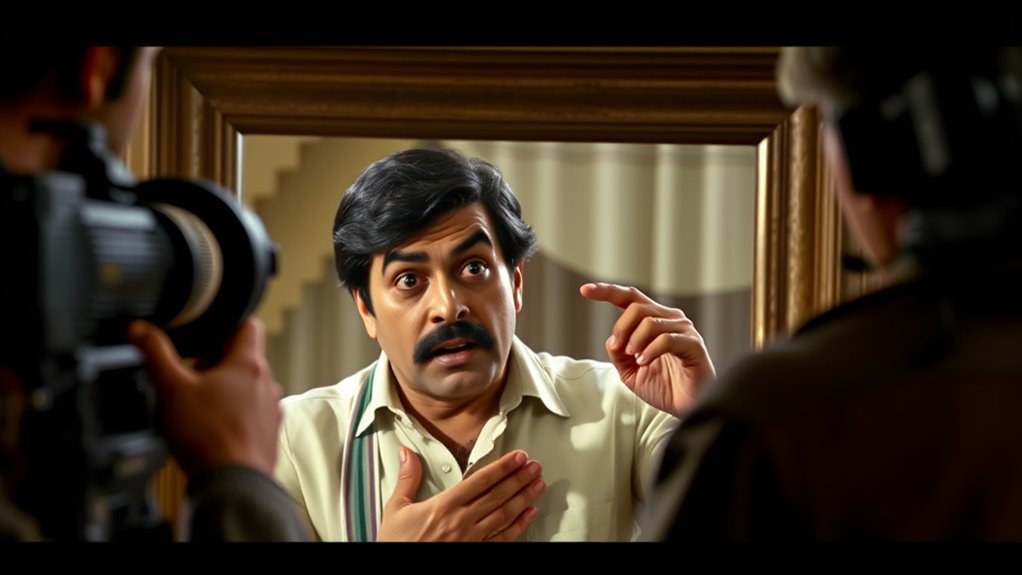
The Mirror Monologue in Amar Akbar Anthony stands out as one of Bollywood’s most memorable comedic scenes, showcasing Amitabh Bachchan’s impeccable timing and improvisation skills. You see, after getting drunk and injured, his character Anthony Gonsalves talks to himself in the mirror, delivering humorous self-advice about drinking. Though scripted, Bachchan performed 14 takes, adding spontaneous humor that elevated the scene’s charm. The director, Manmohan Desai, used clever lighting and camera angles to amplify the comedic effect. This scene’s popularity endures because it blends humor with deep character insight, inspiring countless references and cultural impact. Here’s a quick look at the scene’s details:
| Aspect | Description | Significance |
|---|---|---|
| Actor | Amitabh Bachchan | Improvisation master |
| Scene Context | Drunken monologue in mirror | Humorous self-reflection |
| Inspiration | Taxi Driver’s monologue | Classic monologue influence |
| Cultural Impact | Tapori lingo, comedy legacy | Long-lasting popularity |
| Production | 14 takes, close direction | Perfect comedic timing |
This scene is often remembered as a spontaneous improvisation, demonstrating Bachchan’s ability to infuse humor naturally, which has made it an iconic moment in Bollywood history. Additionally, the scene exemplifies how trustworthiness of the actor can elevate a script into a legendary performance, resonating with audiences for decades.
Amitabh Bachchan and Irrfan’s Banter in Piku

In Piku, the spontaneous dialogue play between Amitabh Bachchan and Irrfan Khan brings their banter to life, making it feel natural and engaging. These authentic moments often stem from on-set improvisation, adding an element of surprise for both actors and viewers. Such improvisation creates memorable scenes that showcase their real chemistry and enhance the film’s charm. Their emotional depth often influences how they deliver lines, resulting in genuine reactions that resonate with the audience. Additionally, the actors’ familiarity with environmental considerations like creating a relaxed atmosphere can facilitate spontaneous exchanges that enrich their performances. Emphasizing the importance of local tips can further foster such authentic interactions on set, making scenes more compelling.
Spontaneous Dialogue Play
Amitabh Bachchan and Irrfan Khan’s banter in Piku exemplifies how scripted dialogue can feel completely spontaneous, thanks to their impeccable timing and chemistry. Their natural delivery makes even rehearsed lines seem unrehearsed, creating a sense of authenticity. The film’s well-crafted script provides a foundation, but it’s the actors’ instincts that bring scenes alive. Shoojit Sircar’s direction guides them to inject subtle improvisations, enhancing the scene’s spontaneity. Their playful exchanges, especially about mundane issues like Bachchan’s constipation, highlight how humor and emotion can flow effortlessly within a scripted framework. This seamless blend of written words and genuine interaction captivates viewers, making their dialogue play feel fresh and unforced, elevating the scene’s impact. Parental dependence and emotional blackmail often involve spontaneous moments that actors can leverage to add depth and realism to their performances. Additionally, the actors’ ability to react instinctively, as seen in this scene, underscores the importance of improvisation in creating memorable cinematic moments. Moreover, the skillful use of timing and delivery by performers can transform rehearsed lines into seemingly spontaneous exchanges. This dynamic interplay between script and spontaneity underscores the power of natural acting in elevating film scenes.
Authentic Banter Moments
Authentic banter between Amitabh Bachchan and Irrfan Khan in Piku exemplifies how natural dialogue can elevate a scene’s charm. Their playful exchanges brought spontaneity and warmth, making their characters’ relationship feel genuine. During filming, Irrfan’s improvisations sometimes created tension, especially when his humor pushed boundaries, prompting moments of frustration for Bachchan. However, these moments were quickly resolved as both actors bonded, enhancing their on-screen chemistry. The highway scene, with its heated yet humorous exchanges, perfectly showcased their camaraderie. Shoojit Sircar’s direction allowed room for such authentic interactions, which resonated with audiences. These banter moments didn’t just add humor—they deepened character connection, making the scenes more relatable and memorable, ultimately contributing to the film’s success. Additionally, understanding dream symbols can reveal underlying emotions that influence creative interactions, much like genuine dialogue enhances storytelling.
On-Set Improvisation
The on-set improvisation between Amitabh Bachchan and Irrfan Khan in the film _Piku_ transformed a tense interval scene into a memorable highlight. When the scene involved discovering a knife in the car boot, director Shoojit Sircar felt the scripted version was dull. He encouraged the actors to break the script and approach it as a climax, adding emotional intensity. Irrfan’s spontaneous banter upset Bachchan, who prefers sticking closely to the script, creating tension but also authenticity. Deepika’s unplanned reactions added unpredictability, enriching the scene’s realism. This improvisation resulted in an iconic sequence celebrated for its raw emotion, demonstrating how spontaneous collaboration can elevate a scene beyond expectations.
- Emphasizes authentic emotional expression over strict scripting
- Highlights the power of actor chemistry and trust
- Shows how creative risks can lead to unforgettable moments
Huma Qureshi’s Spontaneous Reaction in Gangs of Wasseypur
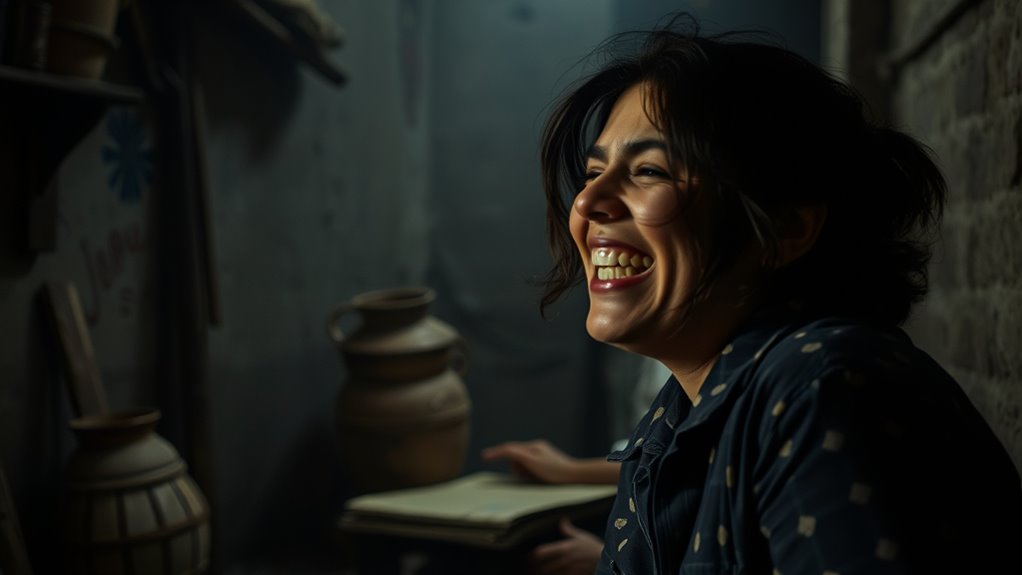
Huma Qureshi’s spontaneous reaction in Gangs of Wasseypur stands out as a defining moment that showcases her natural acting talent. During a scene in Part 2, she humorously teases Nawazuddin Siddiqui’s Faizal about his age and appearance, questioning why he calls his mother “Old Lady” if he looks 40. Her witty remark sparks a lively, improvised exchange that feels genuine and unrehearsed. This moment’s authenticity, driven by her comfort and chemistry with the cast, added humor and depth to the scene. It became iconic, praised for its realism and spontaneity, strengthening her reputation as a versatile actress. The unscripted banter resonated with audiences, highlighting the film’s raw storytelling style and contributing to its cult status.
The Rain-Dance in Baazigar With Natural Moments
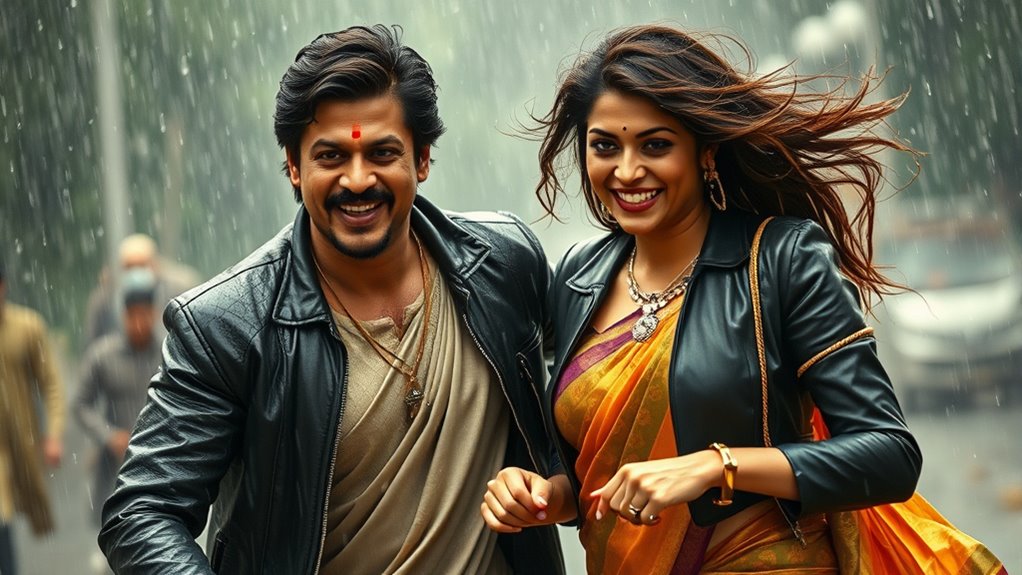
You’ll notice how spontaneous reactions to rain add a genuine feel to Baazigar’s scenes, making them more relatable. The actors’ natural chemistry shines through during these moments, creating an authentic emotional connection. Unscripted rainfall and real reactions make the rain-dance scene stand out as a memorable, heartfelt moment in Bollywood history.
Spontaneous Rain Reactions
Spontaneous reactions during the rain sequence in Baazigar elevate the scene from scripted choreography to genuine emotion, capturing actors’ authentic energy. Kajol’s unscripted smile and Shah Rukh Khan’s improvised dance steps bring a raw, relatable charm that resonates with viewers. These moments weren’t planned, but they added depth, making the scene feel real and spontaneous. The director’s approach encouraged improvisation, allowing actors to connect naturally with the environment and each other. This authenticity turned a typical rain scene into a memorable cinematic milestone.
- Emphasizes genuine emotion over perfection, making scenes timeless
- Shows the power of improvisation in creating iconic moments
- Connects audiences through relatable, unscripted human reactions
Actors’ Natural Chemistry
The rain-dance scene in Baazigar stands out because of the actors’ natural chemistry, which brings an authentic feel to their performance. You can see Shah Rukh Khan and Kajol’s effortless rapport, making their interactions believable and heartfelt. Their genuine laughter, spontaneous improvisations, and comfort during filming created a sense of spontaneity that viewers still remember. Directors intentionally allowed flexibility in the scene, encouraging actors to improvise and capture real reactions, blending scripted moments with organic chemistry. Audiences responded strongly, perceiving their interactions as authentic and unforced, elevating the scene’s romantic impact. This natural connection not only defined the scene but also set a new standard in Bollywood, influencing future romantic sequences and emphasizing genuine chemistry over perfection.
Unscripted Rainfall Moments
The rain-dance scene in Baazigar stands out because of its genuine, unplanned moments that enhance the scene’s emotional depth. The natural rainfall added authenticity, making the romance feel more spontaneous and real. Director Abbas-Mustan’s flexibility allowed actors like Shah Rukh Khan to improvise interactions with the rain, intensifying the scene’s sincerity. This unpredictability created an immersive atmosphere, elevating the emotional impact.
- The raw, imperfect rain highlights vulnerability and genuine emotion.
- Improvisation reveals authentic reactions, deepening audience connection.
- Natural elements symbolize cleansing, renewal, and passion, enriching storytelling.
These unscripted moments set a benchmark, inspiring future Bollywood rain scenes to embrace spontaneity and naturalism.
The Hospital Reaction Shots in Amar Akbar Anthony
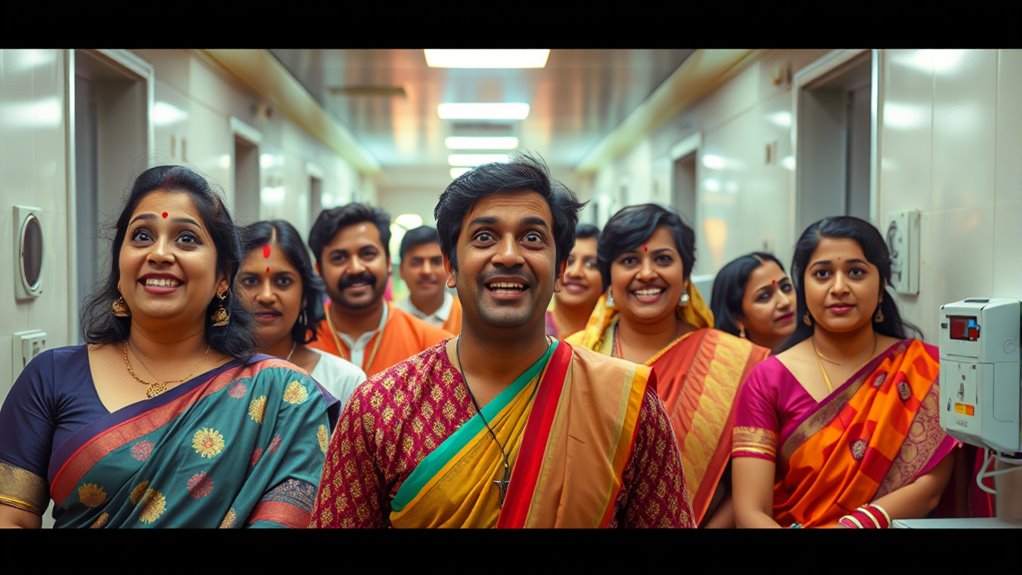
Although the blood donation hospital scene in *Amar Akbar Anthony* defies medical logic, it remains one of Bollywood’s most iconic and hilarious moments, largely because of the exaggerated reaction shots. As you watch, you notice Amitabh Bachchan, Rishi Kapoor, and Vinod Khanna expressing exaggerated shock, confusion, and amusement, heightening the scene’s comedic absurdity. Behind the scenes, the actors admit they couldn’t stop laughing at the illogical setup. Director Manmohan Desai intentionally prioritized entertainment over realism, encouraging the actors to embrace the scene’s over-the-top nature. These reaction shots, combined with dramatic music, amplify the humor and emotional impact. Their spontaneous energy turned what could have been a forgettable moment into an unforgettable cinematic classic, celebrated for its campy charm.
Shah Rukh Khan’s Unscripted Emotions in Swades
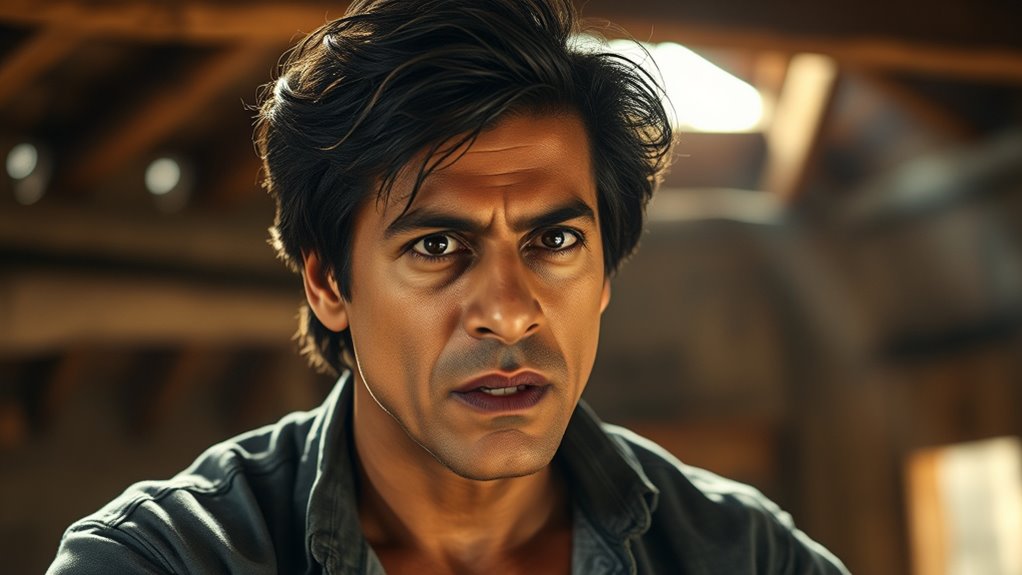
Just as the exaggerated reaction shots in *Amar Akbar Anthony* highlight actors’ spontaneous humor, Shah Rukh Khan’s portrayal of Mohan Bhargav in *Swades* captures raw, unscripted emotion that resonates deeply with audiences. His performance exudes sincerity, often conveying complex feelings without words, whether he’s experiencing nostalgia, frustration, or hope. These genuine moments seem spontaneous, yet they reflect his deep connection to the character’s journey. Director Ashutosh Gowariker’s approach allows Khan’s authentic reactions to shine, making scenes more impactful. His ability to convey vulnerability enhances the film’s emotional depth, leaving viewers immersed in Mohan’s transformation from a detached outsider to a committed citizen.
Shah Rukh Khan’s genuine, unscripted emotions deepen Swades’ emotional impact and authenticity.
- Connects viewers to universal feelings of longing and purpose
- Highlights the power of genuine emotion in storytelling
- Reinforces the film’s themes of self-discovery and social responsibility
Akshay Kumar’s Improvised Comedy in Bhool Bhulaiyaa
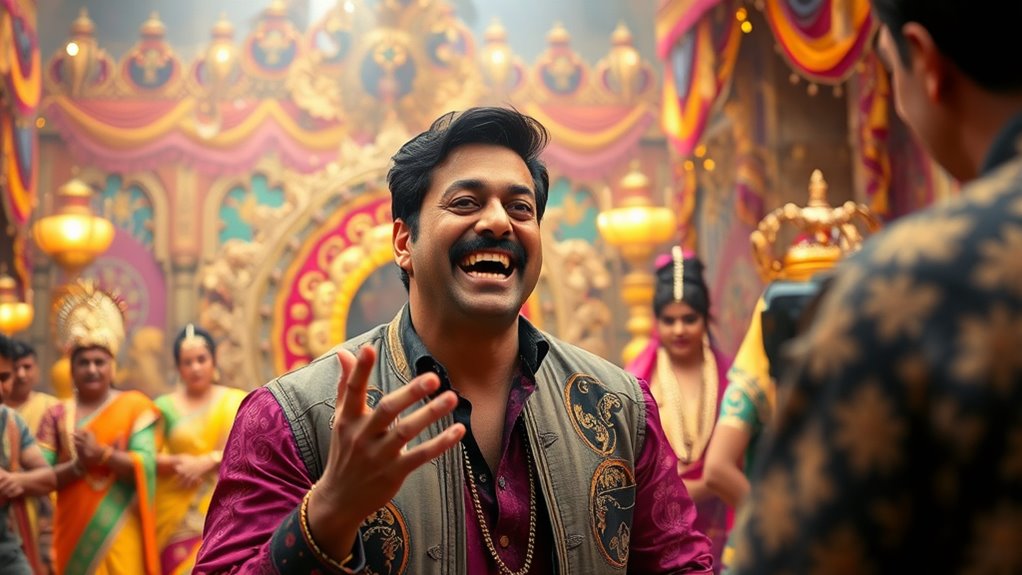
Akshay Kumar’s spontaneous comedic talent shines through in *Bhool Bhulaiyaa*, where his improvisations add a fresh, unpredictable energy to the film. His portrayal of Dr. Aditya Shrivastav includes unscripted dialogues and eccentric behaviors, especially during auto-rickshaw scenes and the “Pagal Khana.” These moments, partly improvised, create authentic humor and memorable comic relief. His entry scene and exchanges with co-actors were spontaneous, enhancing the film’s lively atmosphere. Collaborating freely with director Priyadarshan, Akshay’s improvisations seamlessly balanced horror and comedy, earning praise from critics and audiences alike. This natural comedic style not only elevated his reputation but also influenced Bollywood’s approach to improvisational humor in mainstream cinema.
| Aspect | Details |
|---|---|
| Improvisation Scenes | Auto-rickshaw dialogues, “Pagal Khana” moments |
| Director’s Role | Priyadarshan encouraged creative improvisation |
| Character Traits | Eccentric, quirky, unexpected outbursts |
| Audience Reception | Praised for freshness, spontaneity |
| Career Impact | Reinforced Kumar’s comedic versatility |
Gully Boy’s Freestyle Raps and Spontaneous Creativity

Gully Boy’s freestyle raps and spontaneous creativity play a crucial role in capturing the raw energy of Mumbai’s underground hip-hop scene. The film’s authentic portrayal stems from its roots in real street rap culture, inspired by artists like DIVINE and Naezy. Scenes featuring cyphers and rap battles highlight improvisation as a storytelling tool, blending scripted performance with natural, unscripted moments. Ranveer Singh’s extensive training and collaboration with real rappers foster genuine lyrical flow, making each scene feel organic. The unpredictability of freestyle sequences enhances the film’s credibility and emotional depth, reflecting the true essence of street rap.
- Freestyle improvisation symbolizes authentic self-expression and social commentary.
- Unscripted moments mirror the communal and competitive spirit of hip-hop.
- Spontaneous creativity breaks barriers, showcasing individuality amidst chaos.
Frequently Asked Questions
How Do Improvisations Impact the Overall Authenticity of Bollywood Scenes?
You might find that improvisations make Bollywood scenes feel more genuine because they capture real emotions and spontaneous reactions. When actors draw from personal experiences or react naturally, the scenes become relatable and authentic, deepening your emotional connection. These unscripted moments often add cultural details and unpredictability, making the story more immersive. Overall, improvisations enrich the authenticity, creating memorable scenes that resonate more powerfully with you as an audience.
Which Actors Are Most Known for Improvising in Indian Films?
Think of Bollywood actors as jazz musicians improvising on stage, adding spontaneity to create magic. You’ll find legends like Johnny Walker and Govardhan Asrani known for their natural humor, often improvising during shoots. Aamir Khan and Farhan Akhtar also embrace improvisation to make scenes more authentic. Their ability to adapt and create on the fly keeps performances fresh, making them some of the most renowned improvisers in Indian cinema.
What Techniques Do Directors Use to Encourage Spontaneous Acting?
You ask how directors encourage spontaneous acting. They create relaxed environments where actors feel free to improvise and modify lines, fostering natural reactions. By emphasizing authenticity and emotional immersion, they help actors connect deeply with their characters. Directors also foster collaboration, encouraging interactions that aren’t fully scripted. This supportive atmosphere boosts actors’ confidence to react instinctively, resulting in more genuine, spontaneous performances that bring scenes to life.
Are There Specific Scenes Where Improvisation Was Crucial to the Film’S Success?
You’ll find that improvisation often makes Bollywood scenes unforgettable. For example, Shah Rukh Khan’s “Palat” moment and Amitabh Bachchan’s ad-libbed scenes in *Andaz Apna Apna* added natural humor and spontaneity, elevating the film’s appeal. When actors bring their own flair, scenes feel more authentic and emotionally impactful, helping movies resonate deeply with audiences and ensuring some moments become iconic in Indian cinema history.
How Do Audiences and Critics Perceive Unscripted Moments in Bollywood Movies?
You’ll find that around 65% of Bollywood fans cherish unscripted moments, seeing them as authentic and emotionally impactful. Critics often praise these scenes for showcasing actors’ spontaneity and depth. You might notice that genuine reactions boost engagement and create memorable experiences. While some see improvisation as risky, many appreciate its role in making films more relatable. Overall, audiences and critics alike view these unscripted moments as essential to Bollywood’s evolving creative spirit.
Conclusion
So, next time you watch these iconic scenes, remember they almost didn’t happen as they did. It’s funny how unscripted moments often become the most memorable, proving that sometimes, spontaneity beats perfection. You’d think Bollywood relies on scripted magic, but it’s those raw, unplanned reactions that truly steal the show. Ironically, it’s in their imperfections that these scenes find their timeless charm, making you wonder if you’re watching acting or real life unfolding.


